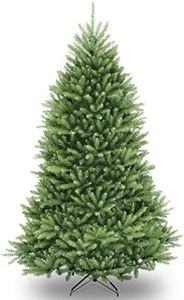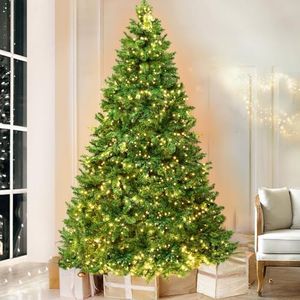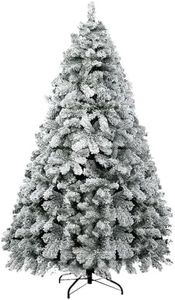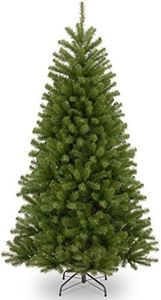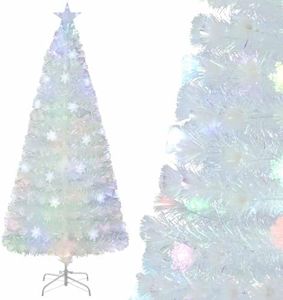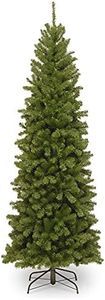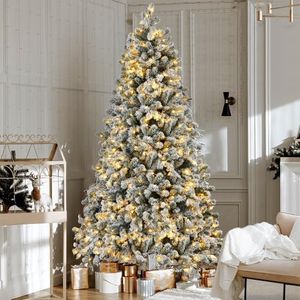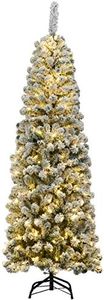We Use CookiesWe use cookies to enhance the security, performance,
functionality and for analytical and promotional activities. By continuing to browse this site you
are agreeing to our privacy policy
10 Best Artificial Christmas Trees
From leading brands and best sellers available on the web.By clicking on a link to a third party's website, log data is shared with that third party.
Buying Guide for the Best Artificial Christmas Trees
Choosing the right artificial Christmas tree can make a big difference in the enjoyment, convenience, and look of your holiday celebrations. When picking a tree, focus on aspects that create the visual impact you want for your space, fit your storage and display needs, and make the whole experience as hassle-free as possible year after year. Understanding the various features and specifications will help you narrow down your choices and select a tree that matches your lifestyle, decorating style, and maintenance preferences.Tree HeightTree height refers to how tall the artificial Christmas tree stands from base to tip. This is important because the height needs to fit your space comfortably, leaving some room between the top of the tree and your ceiling for a tree topper. Artificial trees usually come in segments: short (under 5 feet) for tabletops and tight spaces, medium (6 to 7.5 feet) for most standard living rooms, and tall (8 feet and above) for spacious or high-ceiling areas. To choose the right height, measure your ceiling and subtract 6 to 12 inches (to include a topper if desired), and also consider how much floor space you want to dedicate to the tree.
Tree Width or ShapeTree width indicates how much space the branches of your tree will take up, and it's typically described as full, slim, or pencil. A full-width tree offers a traditional, lush look and requires more floor space, ideal for open areas. Slim and pencil trees have a narrower profile, making them perfect for apartments, corners, or smaller rooms while still giving that vertical visual impact. Consider your available floor space and the look you want—go for fuller for a classic statement or slimmer for tight spaces or a modern vibe.
Branch Tip Count and RealismBranch tip count is the number of individual tips (ends of branches) on a tree. More tips usually mean a fuller, more realistic appearance, letting you hang more ornaments and giving a denser look. Fewer tips create a sparser or more minimalist style. Higher tip counts, along with technology like molded or 'real feel' tips, enhance realism, while lower tip counts and simple shapes can be lighter and easier to assemble. Think about whether you want an ultra-full, realistic tree or if a simpler, easier-to-handle tree is enough for your needs, especially if you have a lot or few ornaments.
LightingLighting refers to whether the tree comes pre-lit with built-in lights or is unlit, requiring you to string your own. Pre-lit trees are available with different types of lights: clear/white, multicolored, or even color-changing LED options. Some have features like twinkle effects, remote control, or replaceable bulbs. Unlit trees give you more freedom to customize but involve extra setup. If you want speed and convenience, pre-lit is great; if you like changing your color scheme each year, unlit may suit you better.
Material and Fire ResistanceMaterial refers to the type of plastic used for the needles and branches, usually PVC or PE. PE (polyethylene) tips tend to have a more realistic look and softer feel, while PVC is more common and can be more affordable. Fire resistance is essential for safety—most modern artificial trees are treated to be flame-retardant. Always check for labeling to ensure the tree meets safety standards. If lifelike looks matter to you, seek more PE content; if safety is a concern, always verify for fire resistance.
Assembly and StorageAssembly relates to how the tree goes together. Some trees have hinged branches that stay attached and fold down, making setup and takedown quicker. Others have individual branches that must be hooked in by hand, which takes more time but can be easier to store in smaller pieces. Storage also depends on whether the tree compresses well or comes with a storage bag. Consider how much time and energy you want to spend each year setting up and packing away the tree—choose a design for convenience if you want quick assembly or for modularity if you have limited storage space.
